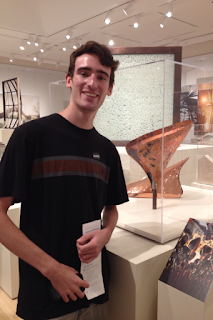Making Strange has quite a fitting name. The mixture of the
surreal and uneasy is meant to evoke new thoughts on what is an accepted form
of fashion, art, and the human body. First I would like to discuss the portion
of the exhibit that focuses on a distortion of the human form. Figure 1
displays an anatomical model that has been configured with a scapula erupting
from the chest cavity and several other misplaced organs.
Figure 1: Disfigured anatomical model
This work of art shows an intentional perversion of the
human body. Bits are jumbled up, disproportionate, and mixed together. This
piece of art really speaks to the sections regarding the human body, especially
in biotechnology. Disrupting the human form is something that is generally frowned
upon and seems innately repulsing. Classical descriptions have always praised
the human body, where here we look at it from a different perspective. This
change in perspective really allows the observer to appreciate what is the
strange.
Moving along, I will focus more on the Gagawaka pieces of
art that form fashionable attire from nonconventional materials. Figure 2
displays a dress made from x ray film.
Figure 2: A dress made from x ray film
This piece directly bridges the gap between medicine and
fashion. I really enjoyed this piece in that anything could be transformed into
fashionable wear. In addition, the garment has an added layer of depth in the x
ray film. I made an effort to look closely at the film to check for any broken
bones! I appreciate this kind of art that warrants close inspection and an
attention to details.
The final piece I will discuss can relate back to our
section on art and neuroscience. Figure 3 displays a clean room jumper filled
with pills.
Figure 3: A jumpsuit filled with colorful pills
These pills can be a social commentary on the overabundance
of prescription drug usage by the public. Drugs can be used to augment our
minds and thoughts in order to change our perspective on the world. This theme
of changing perspective is prevalent throughout the entire exhibit. The theme
of changing one’s perspective is vital in order to be open-minded and see the
world differently. Those who see the world differently will make the world
different.
Lastly here is a picture of me posing with the exhibit
title!

















